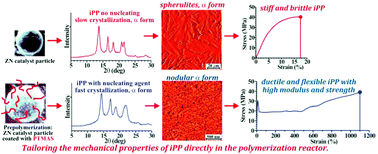Tailoring the properties of polypropylene in the polymerization reactor using polymeric nucleating agents as prepolymers on the Ziegler–Natta catalyst granule†
Abstract
Innovation of the Ziegler–Natta polymerization process for polymerization of propene that allows tailoring of the mechanical properties of isotactic polypropylene (iPP) directly in the polymerization stage is presented. The catalyst is modified by prepolymerization of trimethylallylsilane or vinylcyclohexane so that the catalyst particles are coated by a thin skin of poly(trimethylallylsilane) or poly(vinylcyclohexane) that will act as a nucleating agent for the crystallization of iPP. The presence of the nucleating agent accelerates the crystallization of iPP and affords crystallization of the α form even upon fast crystallization by quenching the melt, a condition that generally produces crystallization of the mesomorphic form. Crystals of the α form so obtained show a nodular morphology and the absence of the spherulitic superstructure. This novel iPP material is characterized by outstanding and unexpected properties of high mechanical strength and modulus and contemporarily high ductility, flexibility and good transparency due to the nodular morphology of the α form.



 Please wait while we load your content...
Please wait while we load your content...